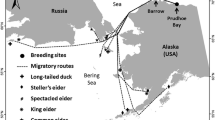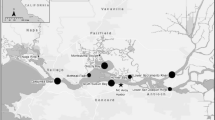Abstract
High concentrations of some hepatic elements might be contributing to the decline of the continental lesser scaup (Aythya affinis) population. We evaluated hepatic element concentrations of male and female lesser scaup collected from the upper Midwest (Iowa, Minnesota, North Dakota, and South Dakota) during the 2003 and 2004 spring migrations. We measured concentrations of 24 elements in livers of 117 lesser scaup. We found that only selenium concentrations were at levels (>3.0 μg/g wet weight [ww)]) proposed to adversely affect reproduction. Approximately 49% of females (n = 61) had individual hepatic concentrations >3.0 μg/g ww selenium (Se). Our observed hepatic concentration of Se was similar to that reported in lesser scaup collected from the mid-continental United States but less than Se concentrations reported from the Great Lakes region. We found that the liver cadmium (Cd) concentration for males was significantly higher than that for females. Gender differences in hepatic Cd concentrations have not been previously reported for lesser scaup, but Cd is known to have negative impacts on male reproduction. Our results indicate that lesser scaup migrating through the upper Midwest in spring have elevated Se levels and that males carry a significantly greater Cd burden than females. Moreover, elemental concentrations might be high enough to affect reproduction in both male and female lesser scaup, but controlled laboratory studies are needed to adequately assess the effects of Se and Cd on lesser scaup reproduction.
Similar content being viewed by others
References
Afton AD, Anderson MG (2001) Declining scaup populations: a retrospective analysis of long-term population and harvest survey data. J Wildl Manage 65:781–796
Anteau MJ, Afton AD (2004) Nutrient reserves of lesser scaup during spring migration in the Mississippi Flyway: a test of the Spring Condition Hypothesis. Auk 121:917–929
Anteau MJ, Afton AD, Custer CM, Custer TW (2007) Relationships of cadmium, mercury, and selenium with nutrient reserves of female lesser scaup (Aythya affinis) during winter and spring migration. Environ Toxicol Chem 26:515–520
Austin JE, Afton AD, Anderson MG, Clark RG, Custer CM, Lawrence JS, Pollard JB, Ringelman JK (2000) Declines of greater and lesser scaup populations: issues, hypotheses, and research needs. Wildl Soc Bull 28:254–263
Beyer WN, Dalgarn J, Dudding S, French JB, Mateo R, Miesner J, Sileo S, Spann J (2004) Zinc and lead poisoning in wild birds in the Tri-State Mining District (Oklahoma, Kansas, and Missouri). Arch Environ Contam Toxicol 48:108–117
Burger J, Gochfeld M (1985) Comparisons of nine heavy metals in salt gland and liver of greater scaup (Aythya marila), black duck (Anas rubripes) and mallard (Anas platyrhynchos). Comp Biochem Physiol C 81:287–292
Cohen JB, Barclay JS, Major AR, Fisher JP (2000) Wintering greater scaup as biomonitors of metal contamination in federal wildlife refuges in the Long Island region. Arch Environ Contam Toxicol 38:83–92
Custer CM, Custer TW (2000) Organochlorine and trace element contamination in wintering and migrating diving ducks in the southern Great Lakes, USA, since the zebra mussel invasion. Environ Toxicol Chem 19:2821–2829
Custer CM, Custer TW, Anteau MJ, Afton AD, Wooten DE (2003) Trace elements in lesser scaup (Aythya affinis) from the Mississippi Flyway. Ecotoxicology 12:47–54
DeVink J-MA, Clark RG, Slattery SM, Scheuhammer TM (2008a) Effects of dietary selenium on reproduction and body mass of captive lesser scaup. Environ Toxicol Chem 27:471–477
DeVink J-MA, Clark RG, Slattery SM, Wayland M (2008b) Is selenium affecting body condition and reproduction in boreal breeding scaup, scoter, and ring-necked ducks? Environ Pollut 152:116–122
Dierenfeld ES, Atkinson S, Craig AM, Walker KC, Streich WJ, Clauss M (2005) Mineral concentrations in serum/plasma and liver tissue of captive and free-ranging rhinoceros species. Zoo Biol 24:51–72
DiGiulio RT, Scanlon PF (1984) Heavy metals in tissues of waterfowl from the Chesapeake Bay, USA. Environ Pollut 35:29–48
Eisler R (1988) Lead hazards to fish, wildlife, and invertebrates: a synoptic review. US Fish and Wildlife Service Biological Report 85(1.14), Contaminant Hazard Reviews Report No 14. US Fish and Wildlife Service, Washington, DC
Eisler R (1998) Nickel hazards to fish, wildlife, and invertebrates: a synoptic review. US Geological Survey Biological Science Report, Contaminant Hazard Reviews Report No 34. USGS, Washington, DC
Fisk AT, de Wit CA, Wayland M, Kuzyk ZZ, Burgess N, Letcher R, Braune B, Norstrom R, Polischuk Blum S, Sandau C, Lie E, Larsen HJS, Utne Skaare J, Muir DCG (2005) An assessment of the toxicological significance of anthropogenic contaminants in Canadian arctic wildlife. Sci Total Environ 351–352:57–93
Furness RW (1996) Cadmium in birds. In: Beyer WN, Heinz GH, Redmon-Norwood AW (eds) Environmental contaminants in wildlife: interpreting tissue concentrations. CRC Press, Boca Raton, FL, pp 389–404
Furness RW, Hutton M (1979) Pollutant levels in the great skua Catharacta skua. Environ Pollut 19:261–268
Gasaway WC, Buss IO (1972) Zinc toxicity in the mallard duck. J Wildl Manage 36:1107–1117
Gochfeld M, Burger J (1987) Heavy metal concentrations in the liver of three duck species: influence of species and sex. Environ Pollut 45:1–15
Heinz GH (1974) Effects of low dietary levels of methylmercury on mallard reproduction. Bull Environ Contam Toxicol 11:386–392
Heinz GH (1976a) Methylmercury: second-generation reproductive and behavioral effects on mallard ducks. J Wildl Manage 40:710–715
Heinz GH (1976b) Methylmercury: second-year feeding effects on mallard reproduction and duckling behavior. J Wildl Manage 40:82–90
Heinz GH (1979) Methylmercury: reproductive and behavioral effects on three generations of mallard ducks. J Wildl Manage 43:394–401
Heinz GH (1996) Selenium in birds. In: Beyer WN, Heinz GH, Redmon-Norwood AW (eds) Environmental contaminants in wildlife: interpreting tissue concentrations. CRC Press, Boca Raton, FL, pp 447–458
Heinz GH, Hoffman DJ (1998) Methylmercury chloride and selenomethionine interactions on health and reproduction in mallards. Environ Toxicol Chem 17:139–145
Heinz GH, Hoffman DJ, Sileo L, Aduet DJ, LeCaptain LJ (1999) Toxicity of lead-contaminated sediment to mallards. Arch Environ Contam Toxicol 36:323–333
Henderson BM, Winterfield RW (1974) Acute copper toxicosis in the Canada goose. Avian Dis 19:385–387
Hoffman DJ (2002) Role of selenium toxicity and oxidative stress in aquatic birds. Aquat Toxicol 57:11–26
Hothem RL, Lonzarich DG, Takekawa JE, Ohlendorf HM (1998) Contaminants in wintering canvasbacks and scaups from San Francisco Bay, California. Environ Monit Assess 50:67–84
Mochizuki M, Mori M, Akinaga M, Yugami K, Oya C, Hondo R, Ueda F (2005) Thallium contamination in wild ducks in Japan. J Wildl Dis 4:664–668
Ohlendorf HM, Lowe RW, Kelly PR, Harvey TE (1986) Selenium and heavy metals in San Francisco Bay diving ducks. J Wildl Manage 50:64–71
Pain DJ (1996) Lead in waterfowl. In: Beyer WN, Heinz GH, Redmon-Norwood AW (eds) Environmental contaminants in wildlife: interpreting tissue concentrations. CRC Press, Boca Raton, FL, pp 251–264
Pass DA, Little PB, Karstad LH (1975) The pathology of subacute and chronic methyl mercury poisoning of the mallard duck (Anas platyrhynchos). J Comp Pathol 85:7–21
Petrie SA, Badzinski SS, Drouillard KG (2007) Contaminants in lesser and greater scaup staging on the lower Great Lakes. Arch Environ Contam Toxicol 52:580–589
Puls R (1994) Mineral levels in animal health, vol 2. Sherpa International, Clearbrook, BC, Canada
SAS Institute (2003) SAS/STAT user’s guide, version 9 and 9.1. SAS Institute Inc., Cary, NC
Sileo L, Beyer WN, Mateo R (2004) Pancreatitis in wild zinc-poisoned waterfowl. Avian Path 32:655–660
Spallholz JE, Hoffman DJ (2002) Selenium toxicity: cause and effects in aquatic birds. Aquat Toxicol 57:27–37
Stewart FM, Furness RW (1998) The influence of age on cadmium concentrations in seabirds. Environ Monit Assess 50:159–171
Taggart MA, Figuerola J, Green AJ, Mateo R, Deacon C, Osborn D, Meharg AA (2006) After the Aznalcollar mine spill: arsenic, zinc, selenium, lead and copper levels in the livers and bones of five waterfowl species. Envrion Res 100:349–361
Takekawa JY, Wainwright-DeLa Cruz SE, Hothem RL, Yee J (2002) Relating body condition to inorganic contaminant concentrations of diving ducks wintering in coastal California. Arch Environ Contam Toxicol 42:60–70
Wayland M, Gilchrist HG, Neugebauer E (2005) Concentrations of cadmium, mercury and selenium in common eider ducks in the eastern Canadian arctic: influence of reproductive stage. Sci Total Environ 351–352:323–332
White DH, Finley MT (1978) Uptake and retention of dietary cadmium in mallard ducks. Environ Res 17:53–59
Wobeser GA (1997) Diseases of wild waterfowl, vol 2. Plenum Press, New York
Wood EC, Worden AN (1973) The influence of dietary copper concentration on hepatic copper in the duckling and the chick. J Sci Food Agric 24:167–174
Zimpfer NL, Rhodes WE, Silverman ED, Zimmerman GS, Koneff MD (2010) Trends in duck breeding populations, 1955–2010. Administrative Report. US. Fish and Wildlife Service, Laurel, MD
Acknowledgments
The authors are grateful to S. Vaa, J. Ringelman, M. Anteau, and G. Zenner and their associates for their assistance with duck collections and transport. Our project was possible through the South Dakota and Louisiana Cooperative Fish and Wildlife Research Units in cooperation with the US Geological Survey, the South Dakota Department of Game, Fish and Parks, South Dakota State University, and the US Fish and Wildlife Service. Funding for this research was provided through the Wildlife Restoration Program administered by the South Dakota Department of Game, Fish and Parks (Federal aid project W-75-R-75110). The South Dakota Cooperative Fish and Wildlife Research Unit is jointly supported by the US Geological Survey, South Dakota State University, South Dakota Department of Game, Fish & Parks, US Fish and Wildlife Services, and the Wildlife Management Institute.
Author information
Authors and Affiliations
Corresponding author
Rights and permissions
About this article
Cite this article
Pillatzki, A.E., Neiger, R.D., Chipps, S.R. et al. Hepatic Element Concentrations of Lesser Scaup (Aythya affinis) During Spring Migration in the Upper Midwest. Arch Environ Contam Toxicol 61, 144–150 (2011). https://doi.org/10.1007/s00244-010-9587-1
Received:
Accepted:
Published:
Issue Date:
DOI: https://doi.org/10.1007/s00244-010-9587-1




